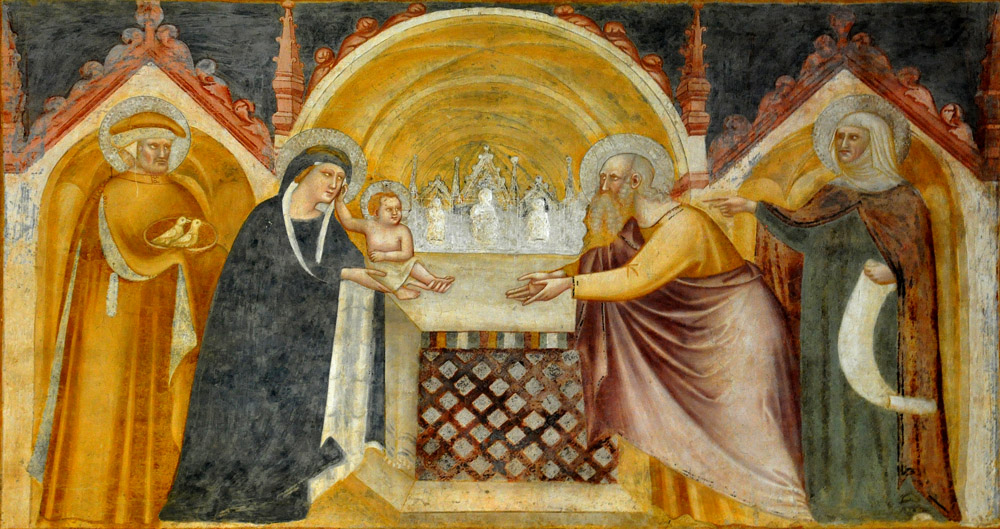THE SACRED VICTIM
In the images of this conflated event, Mary and Joseph bring to the Temple both the two doves for Mary's purification and their son for the dedication and ransom. In many medieval images the child is pictured either upon an altar (example) or just above and in front of it, as in the picture at the top of this page. The altar keeps the viewer in mind that the child Jesus is the sacrifical "lamb of God who takes away the sins of the world" (John 1:29) through his redemptive sacrifice on the cross. In a sermon on the Presentation, Bernard of Clairvaux urges Mary, "Offer your son, sacred Virgin, and present to the Lord the blessed fruit of your womb. Offer the sacred victim (hostia), pleasing to God, that all of us may be reconciled to him. He is sure to accept this new oblation, this precious victim." And in the York play of the Presentation, when Mary laments having no lamb to offer, Joseph says, "Our baby Jesus…is our lamb, Mary.… He is the lamb of God, I say / who all our sins shall take away."1 In the same spirit Salviati's Presentation of Jesus in the Temple emphasizes the "ransoming" of the child by having Mary hold the doves out to the high priest, who holds the child. The artist ties this ransoming to the adult Christ's sacrificial death for the redemption of mankind by placing an angel above the child holding a rod and a crown of thorns.SIMEON AND ANNA
In the East, the event is called the Hypapante (a "meeting" or "going toward"). This title is especially appropriate to the character of Simeon, the prophet who has been "waiting for the consolation of Israel" (in the Vulgate, expectans consolationem Israel, Luke 2:25) and who now takes the child in his arms and says his "eyes have seen your salvation." Almost invariably images in both East and West make his reception of the child the central event. Because of a passage in the Protevangelium (24) he was believed to be a priest, but in the images he is rarely dressed as one. Wearing the same flowing robes as the others, he seems to represent every person hoping for the "consolation." that is to come precisely from this child.As a sign of Israel's long wait for consolation, Simeon is always presented as an old man in the images and in some of the apocryphal gospels.2
In medieval mystery plays Simeon bespeaks the longings of the just for God's redemption.3 Some images make this longing reciprocal through the gestures of Simeon and the baby. In this mosaic in Sicily, the two reach their arms toward each other across a wide distance punctuated by a small image of a ciborium. The Ugljan Triptych in Zadar also puts the two figures on either side of a ciborium, their arms reaching toward each other.4 In contrast, however, some later works such as the picture above may prefer a more naturalistic effect with the baby reaching back to the mother and away from the scary stranger.
Until the 14th century Simeon always received the child with hands covered by his mantle (example) or by a separate cloth (example). This tradition arose from the Gospel of Pseudo-Matthew (15), which said that when Simeon saw the child he "took him up into his cloak and kissed his feet." It continued in the West even into the 16th century (example). But it was not mentioned in the Golden Legend, so we start to see uncovered hands in the West in the 14th century, as in the picture above.
In the 15th and especially the 16th centuries, the child himself may be half- or fully naked.
An aged prophetess named Anna is also present in Luke's account and is in many Presentation images. The mystery plays make her a representative of mankind's longings as well, but in the images she usually just stands to the side.
THE FULFILMENT OF PROPHECY
Medieval commentators saw the Presentation event as the fulfilment of prophecies in scripture, and a lengthy passage in the Chester Purification play has Simeon and Anna studying the scriptures together.5 The reliefs at Orvieto Cathedral have Simeon reading a book before the Presentation occurs, and a book is on the altar in a 13th-century Presentation image in Rome. Representing the "Word of God," the book on the altar is also a reference to Christ, who "in the beginning was the Word" (John 1:1) as sacred victim. Simeon calls the child "a light to the revelation of the Gentiles" and tells Mary, "thy own soul a sword shall pierce." These remarks have a lasting impact on liturgy and iconography in the West. The comment about the sword leads to a subset of the Sorrowful Mother type in which Mary's breast is pierced by a sword (example). The comment about light to the Gentiles led to the celebration of the feast of Candlemas. On February 2, 40 days after Christmas, the faithful bring candles to the church to be blessed and lighted. Medieval and later images of the Purification / Presentation normally include candles to refer to the feast and to the belief that Christ is indeed the light to the Gentiles (Catholic Encyclopedia, s.v. "Candlemas").In Latin countries, La Candelaria is the name both for Candlemas and for a santo of the Virgin and Child that is processed on that day. The santo typically wears a crown and has the Christ Child in her arms and a candle or other symbolic object in one hand. Sometimes the child also wears a crown.
THE PLACE AND THE PEOPLE
Luke says Simeon greeted the child after going "into the Temple." Western medieval images follow suit by putting the figures in an interior space with some details suggesting the Jerusalem Temple (example). But earlier works show the action as if outdoors (example).Mary, the baby, and Simeon are always in the image, often accompanied by Joseph and Anna. Sometimes there will be a whole throng of bystanders. One addition in some later medieval works is a young woman with uncovered hair carrying the basket of doves (example). She could possibly be one of the virgins the priests assigned as Mary's companions in the apocryphal gospels.6
Sometimes viewers the Presentation in the Temple can be confused with the Circumcision, which occurred on the 8th day of the child's life. For example, the candles in this fresco
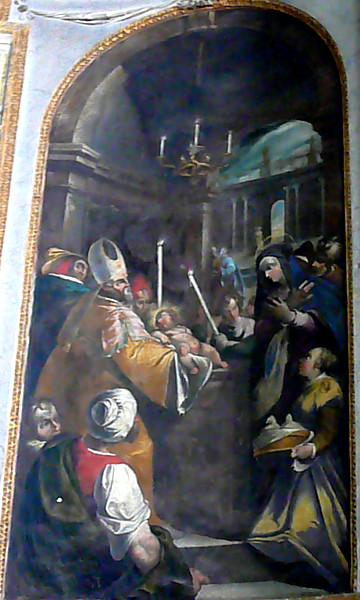
Prepared in 2015 by Richard Stracke, Emeritus Professor of English, Augusta University.
HOME PAGE
Detail from the New Testament frescoes at Pomposa Abbey (early 14th century). See the description page for details.
OTHER IMAGES
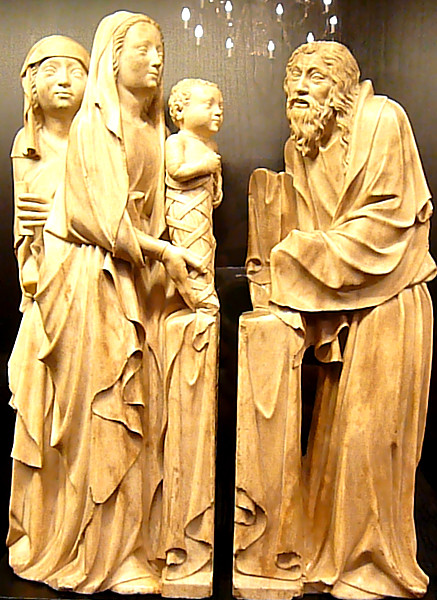
The altar is divided between the two halves of this marble Presentation group from the late 14th century. The candle held by the woman at left alludes to "Candlemas," a late alternative name for the Feast of the Purification of the Blessed Virgin, February 2. See the description page.
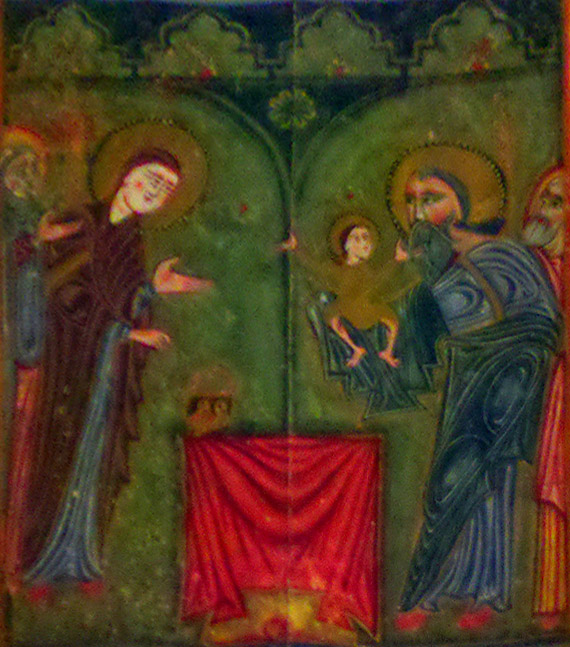
Like Western Presentation images of the same era, this 15th-century manuscript illustration from Armenia uses an altar to allude to the sacrifice for which the Christ Child was born. – See the description page.
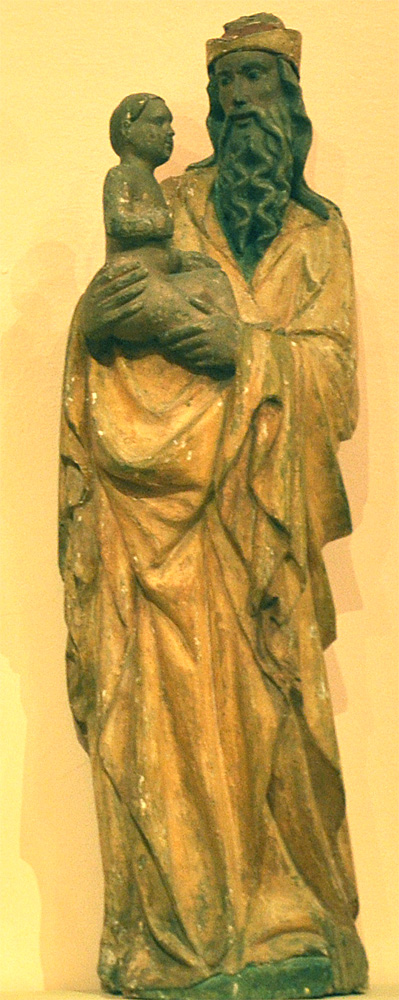
In this statue from a Franciscan monastery, the child is represented as completely naked. See the description page.
MORE IMAGES
- 1160-1180: The Presentation in the Temple is the third of the ten panels outlining the Life of Christ on a German portable altar.
- 1303-1305: Giotto's fresco in the Scrovegni Chapel.
- 1325-70: Panel 5, window 3 in Regensburg Cathedral's Life of Mary Windows
- 1344: Detail from Guariento di Arpo's Coronation of the Virgin altarpiece.
- 15th century: Byzantine icon of the Hypapante.
- 1479: The Presentation is pictured in the open state of Memling's Jan Floreins Triptych.
- 1521: A rare case where it is the High Priest, not Simeon, who takes the child in his arms.
- 17th or 18th century: A dressed santo in Teitipac, Oaxaca.
- 21st century: A posterboard image of La Candelaria created for a fiesta in Santa Fe, New Mexico.
- Undated: A painting of St. Helena having a Vision of the Presentation in the Temple.
DATES
- The feast day celebrating the Presentation is on February 2. That day is sometimes called Candlemas.
RELEVANT TEXTS
- Golden Legend #37: html or pdf
- Gospel of Pseudo-Matthew
- The Gospel of the Nativity of Mary
- Acta Sanctorum, February vol. 1, 268-79
- Roman Breviary: 1908 English translation, I, 736; 1632 Latin version, 817-21
- Methodius, Oration Concerning Simeon and Anna.
NOTES
1 Patrologia Latina, CLXXXIII, 370 (my translation). Davidson, 120.
2 Chapter 24 of The Protevangelium of James says Simeon was the priest who replaced Zechariah after the latter's execution by Herod. The Arabic Gospel of the Infancy, ¶6, says Simeon was "old," and The Gospel of Pseudo-Matthew, chapter 15, has him "a hundred and twelve years old."
3 York Play #17:87-164, Chester Play #11:1-24.
4 Petricioli, 66. The Presentation is pictured on the second panel of the left wing of the triptych. Venetian or Zadarian painter, tempera on wood, beginning of the 14th century. In the Zadar Regional Museum, Zadar, Croatia.
5 See for example see Nicholas of Lyra's interpretation of Luke 2:25, In Jerusalem as "In a solemn and sacred place, for in that place were both the divine cult and the study of the Law and the Prophets.… At that time it was the common opinion of the learned that the coming of Christ was imminent, according to the signs given to the patriarchs and prophets" (Glossa Ordinaria, V, 717-18). Bede (ibid.) also remarks, on the Holy Ghost's promise to Simeon, that "just as he [the Christ] was presaged to the faithful from all ages, so his arrival was predicted to all the just." For the Chester passage see Deimling, The Chester Plays, I, 206-209 (Play #11:25-104).
6 The Gospel of Pseudo-Matthew, ¶8. The Gospel of the Nativity of Mary, ¶8. Both texts say the virgins were assigned to accompany Mary until her marriage. The young women pictured in some images of the Visitation are probably from this group as well.
